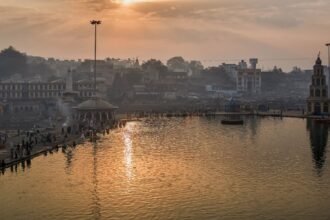The Kumbh Mela, one of the largest gatherings of human beings on Earth, is increasingly facing a new challenge: Kumbh Mela climate safety. As millions of pilgrims get ready for upcoming events like the Kumbh Mela in Nashik in 2027, officials are now taking into account heat waves, unpredictable rain, and unusual weather patterns to make sure the Kumbh Mela is safe.
This blog talks about how rising temperatures are affecting the health and safety of pilgrims, what steps are being taken to safeguard them, and what you can do as a tourist to keep safe.
The Heat is Real: Pilgrims at Risk
Extreme heat has been one of the most obvious effects of climate change at recent Kumbh Melas. During past summer melas, daytime temperatures have gone above 40°C (104°F), which puts older pilgrims, youngsters, and anyone with pre-existing ailments at considerable risk of heatstroke, dehydration, and exhaustion.
Things that make heat-related dangers worse:
Crowd density in open, unshaded areas
Long queues for darshan and Snan (bathing) without shelter
Blacktop roads that give off heat
Urban heat island effect in temporary tent cities
These conditions need to be taken care of right away for kumbh mela climate safety in 2027 and beyond.
Flooding and Water Management
During the day, heat is a danger, but so is rain that comes out of nowhere and floods. This is especially true during Nashik’s monsoon season, which runs from July to October.
Low-lying riverbank areas can get waterlogged or submerged
Pilgrim camps near Godavari Ghats can face flash floods
Sanitation and drinking water quality degrade during floods
For example, in 2015, excessive rain during Nashik Simhastha caused brief pandemonium in some Akhara districts and made officials reassess how to build slopes and drain water.
Climate-Smart Safety Measures in Place
Fortunately, both the state and central governments, as well as environmental planners and NGOs, are working hard to make sure that the kumbh mela is safe for the environment:
Improvements to infrastructure
Flood-resistant campsites on elevated terrain
Concrete drainage channels and portable water treatment systems
Weather-resilient tent materials for camps and community kitchens
Heat Protection Measures
Setting up water misting tunnels and cooling fans near busy paths
Shade nets and resting zones at Snan Ghats and Akhara entrances
Mobile health clinics that have oral rehydration salts and electrolytes
Smart Tech Solutions
Use of AI-powered crowd management systems to keep people from gathering in open areas
Systems for keeping an eye on the weather in real time
SMS and app-based alerts for pilgrims during heatwaves
These adaptable tactics are making each Kumbh a more climate-conscious spiritual event, setting new standards for arranging large-scale pilgrimages.
How to Stay Safe as a Pilgrim
If you’re going to the Kumbh Mela in 2027, you can take a few simple steps to protect yourself from the weather:
To avoid getting dehydrated, bring a water bottle that you can fill up again.
Wear cotton garments that are light in colour and let air through.
Snan should not be done at the busiest hours of the afternoon. Instead, do it in the early morning or evening.
Use sunblock and bring a hat or umbrella.
Every day, check the weather on official apps or local warnings.
During heavy rains, stay away from riverbanks and in well-ventilated tent areas.
You can make sure that your spiritual experience stays good and secure by being attentive and ready.
Also read : Kumbh Mela in Nashik 2027: City, Ghats & Spiritual Sites
A Greener Kumbh: The Eco Side
Kumbh officials are also working on environmentally friendly planning for both safety and sustainability:
No more single-use plastics
Putting solar lights in public areas
Encouragement of eco-toilets and bio-waste processing units
These adjustments not only make the kumbh mela safer for the environment, but they also make it smaller.
Conclusion
As climatic patterns get worse, so does the need for organising pilgrimages that are safe for the climate. The Kumbh Mela climate safety activities that are going on right now are very important for keeping this old ritual alive for future years.
Kumbh Mela 2027 and beyond will be just as much about being a good host as they are about spiritual awakening. This includes better infrastructure, wiser crowd control, and more environmentally friendly activities.
If you want to go, be a part of this change. Plan ahead, travel in a way that doesn’t harm the environment, and take care of your health. Safety and spirituality should go hand in side.





